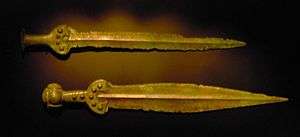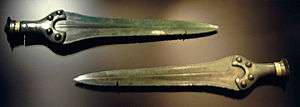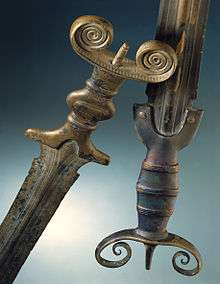Bronze Age sword

Bronze Age swords appear from around the 17th century BC, in the Black Sea region and the Aegean, as a further development of the dagger. They are replaced by the Iron Age sword during the early part of the 1st millennium BC.
From an early time the swords reach lengths in excess of 100 cm. The technology to produce blades of such lengths appears to have been developed in the Aegean, using alloys of copper and tin or arsenic, around 1700 BC. Typical Bronze Age swords had lengths of roughly between 60 and 80 cm, while weapons significantly shorter than 60 cm also continued to be made, but are variously categorized as "short swords" or as daggers. Before 1400 BC or so, swords remain mostly limited to the Aegean and southeastern Europe, but they become more widespread in the final centuries of the 2nd millennium, to Central Europe and Britain, to the Near East, Central Asia, Northern India and to China.
Predecessors
Before bronze, stone (flint, obsidian f.e.) was used as the primary material for edged cutting tools and weapons. Stone, however, is very fragile, and therefore not practical to be used for swords. With the introduction of copper, and subsequently bronze, daggers could be made longer, leading to the sword.
Thus, the development of the sword from the dagger was gradual, and in 2004 the first "swords" were claimed for the Early Bronze Age (c. 33rd to 31st centuries), based on finds at Arslantepe by Marcella Frangipane of Rome University.[1][2][3] A cache of nine swords and daggers was found; they are composed of arsenic-copper alloy. Among them, three swords were beautifully inlaid with silver.
These are the weapons of a total length of 45 to 60 cm which could be described as either short swords or long daggers. Some other similar swords have been found in Turkey, and are described by Thomas Zimmermann.[4]
The sword remained extremely rare for another millennium, and became more widespread only with the closing of the 3rd millennium. The "swords" of this later period can still readily be interpreted as daggers, as with the copper specimen from Naxos (dated roughly 2800 to 2300 BC), with a length of just below 36 cm, but individual specimens of the Cycladic "copper swords" of the period around 2300 reach a length up to 60 cm. The first weapons that can be classified as swords without any ambiguity are those found in Minoan Crete, dated to about 1700 BC, which reach lengths of more than 100 cm. These are the "type A" swords of the Aegean Bronze Age.
Aegean
The Minoan and Mycenaean (Middle to Late Aegean Bronze Age) swords are classified in types labeled A to H following Sandars (1961, 1963), the "Sandars typology". Types A and B (Tab-tang) are the earliest from about the 17th to 16th centuries, types C (Horned swords) and D (Cross swords) from the 15th century, types E and F (T-hilt swords) from the 13th and 12th. The 13th to 12th centuries also see a revival of the "Horned" type, classified as types G and H.[5] Type H swords are associated with the Sea Peoples and were found in Anatolia (Pergamon[6]) and Greece. Contemporary with types E to H is the so-called Naue II type, imported from south-eastern Europe.
Europe


Naue II
One of the most important, and longest-lasting, types of prehistoric European swords was the Naue II type (named for Julius Naue who first described them), also known as Griffzungenschwert or "grip-tongue sword". It first appears in c. the 13th century BC in Northern Italy (or a general Urnfield background), and survived well into the Iron Age, with a life-span of about seven centuries, until the 6th century BC. During its lifetime, metallurgy changed from bronze to iron, but not its basic design. Naue II swords were exported from Europe to the Aegean, and as far afield as Ugarit, beginning about 1200 BC, i.e. just a few decades before the final collapse of the palace cultures in the Bronze Age collapse.[9] Naue II swords could be as long as 85 cm, but most specimens fall into the 60 to 70 cm range.
Swords from the Nordic Bronze Age appear from ca. the 13th century BC, often showing characteristic spiral patterns. The early Nordic swords are also comparatively short, a specimen discovered in 1912 in near Bragby, Uppland, Sweden, dated to about 1800 to 1500 BC, was just over 60 cm long. This sword was, however classified as of the Hajdúsámson-Apa type, and was presumably imported. The Vreta Kloster sword discovered in 1897 (dated 1600 to 1500 BC) has a blade length (the hilt is missing) of 46 cm.[10]
A typical variant for European swords is the leaf shaped blade, which was most common in North-West Europe at the end of the Bronze Age, on the British Isles in particular. The carp's tongue sword is a type of bronze sword that was common to Western Europe during ca. the 9th to 8th centuries BC. The blade of the carp's tongue sword was wide and parallel for most of its length but the final third narrowed into a thin tip intended for thrusting. The design was probably developed in north western France and combined the broad blade useful for slashing with a thinner, elongated tip suitable for thrusting. Its advantages saw its adoption across Atlantic Europe. In Britain, the metalwork in the south east derived its name from this sword: the Carp's Tongue complex. Notable examples of this type were part of the Isleham Hoard.
The Bronze Age style sword and construction methods die out at the end of the early Iron Age (Hallstatt D)), around 600-500 BC, when swords are once again replaced by daggers in most of Europe. An exception is the Xiphos from Greece, the development of which continues for several more centuries. The antenna sword is a type of the Late Bronze Age, continued in early iron swords of the East Hallstatt and Italy region.[11]
China
Sword production in China is attested from the Bronze Age Shang Dynasty, from roughly 1200 BC. The technology for bronze swords reached its highpoint during the Warring States period and Qin Dynasty (221 BC – 207 BC). Amongst the Warring States period swords, some unique technologies were used, such as casting high tin edges over softer, lower tin cores, or the application of diamond shaped patterns on the blade (see the sword of Gou Jian). Also unique for Chinese bronzes is the consistent use of high tin bronze (17-21% tin) which is very hard and breaks if stressed too far, whereas other cultures preferred lower tin bronze (usually 10%), which bends if stressed too far. Although iron swords were made alongside bronze, it wasn't until the early Han Dynasty that iron completely replaced bronze, making China the last place where bronze was used in swords.
India
Swords have been recovered in archaeological findings of the Ochre Coloured Pottery culture throughout the Ganges-Yamuna Doab region of India, commonly made of copper, but in some instances made of bronze. Diverse specimens have been discovered in Fatehgarh, where there are several varieties of hilt. These swords have been variously dated to periods between 1700-1400 BC, but were probably used more extensively during 1200-600 BC (Painted Grey Ware culture, Iron Age India).[12]
See also
Notes
- ↑ Oldest Swords Found in Turkey
- ↑ Frangipane, M. et.al. 2010: The collapse of the 4th millennium centralised system at Arslantepe and the far-reaching changes in 3rd millennium societies. ORIGINI XXXIV, 2012: 237-260.
- ↑ Frangipane, "The 2002 Exploration Campaign at Arslantepe/Malatya" (2004)
- ↑ First Swords uni-kiel.de
- ↑ Shalev, Sariel (2004). Swords and daggers in Late Bronze Age Canaan. Franz Steiner Verlag. p. 62. ISBN 978-3-515-08198-6.
- ↑ Benzi, Marion (2002). "Anatolia and the Eastern Aegean at the time of the Trojan War". In Franco Montanari, Paola Ascheri. Omero tremila anni dopo: atti del Congresso di Genova, 6-8 luglio 2000. Edizione di Storia e Letteratura. p. 384. ISBN 978-88-8498-059-5.
- ↑ "the decorative lines on the sword blades that had initially been regarded as incrustations consisted of pure copper hammered into channels that had presumably already been produced in the casting process. Thus the swords are among the very few Early Bronze Age examples of a true inlay technique outside the Mediterranean world [...] An interesting parallel to these has now been found in a sword from the parish of Vreta Kloster in Östergötland, Sweden." Roland Schwab, Inga Ullén, Christian-Heinrich Wunderlich, A sword from Vreta Kloster, and black patinated bronze in Early Bronze Age Europe, Journal of Nordic Archaeological Science 17, 27–35 (2010).
- ↑ "Typologically, the swords from Nebra and Vreta belong to the Sögel blades, which copy the shape and decoration of Hajdúsámson-Apa swords [...] Concerning the provenance of the swords, the area between the rivers Danube and Tisza in present-day Hungary and Romania has been suggested, as also the production in present Germany [...] Vandkilde (1996:240) proposed that these swords and daggers of the Sögel and Wohlde type in southern Jutland could have been manufactured locally." Roland Schwab, Inga Ullén, Christian-Heinrich Wunderlich, A sword from Vreta Kloster, and black patinated bronze in Early Bronze Age Europe, Journal of Nordic Archaeological Science 17, 27–35 (2010).
- ↑ R. Jung, M. Mehofer, A sword of Naue II type from Ugarit and the Historical Significance of Italian type Weaponry in the Eastern Mediterranean, Aegean Archaeology 8, 2008, 111–136.
- ↑ Museum of National Antiquities (Statens Historiska Museum) inventory number SHM 10419.
- ↑ Dennis William, The archaeology of Celtic art, 2007, p. 269.
- ↑ F.R. Allchin in South Asian Archaeology 1975: Papers from the Third International Conference of the Association of South Asian Archaeologists in Western Europe, Held in Paris (December 1979) edited by J.E.van Lohuizen-de Leeuw. Brill Academic Publishers, Incorporated. Pages 106-118. ISBN 90-04-05996-2 (pp. 111-114).
References
- B. Athanassov, R. Krauß, V. Slavčev, 'A Bronze Sword of the Aegean-Anatolian Type in the Museum of Varna, Bulgaria' in: Horejs and Pavúk (eds.): Aegean and Balkan Prehistory (2012)
- T. Bader, Die Schwerter in Rumänien, Prähistorische Bronzefunde IV.8 (1991).
- E. Cline, Aššuwa and the Achaeans: the 'Mycenaean' Sword at Hattušas and its possible Implications. Annual BSA 91, 1996, 137-151.
- John Evans, The Ancient Bronze Implements, Weapons and Ornaments, of Great Britain and Ireland (1881)
- B. Hänsel, Bronzene Griffzungenschwerter aus Bulgarien. Prähist. Zeitschr. 45, 1970, 26-41.
- B. Hänsel, 'Frühe Bronzeschwerter zwischen dem Karpatenbecken und dem Werra-Tal' in: Studia Antiquaria: Festschrift für Niels Bantelmann, 31–39.
- Imma Kilian-Dirlmeier, Die Schwerter in Griechenland (Außerhalb der Peloponnes), Bulgarien und Albanien, Prähistorische Bronzefunde IV.12 (1993).
- A. Müller-Karpe, 'Anatolische Bronzeschwerter und Südosteuropa' In: C. Dobiat (ed.), Festschrift für Otto-Herman Frey, Marburger Studien zur Vor- und Frühgeschichte 16 (1994), 431-444.
- S. Shalev, Redating the "Philistine sword" at the British Museum : a case study in typology and technology., Oxford Journal of Archaeology 7,3 (1988) 303-311.
- S. Shalev, Swords and daggers in Late Bronze Age Canaan, Prähistorische Bronzefunde, Franz Steiner Verlag, 2004.
- N. K. Sandars, The First Aegean Swords and their Ancestry, American Journal of Archaeology 65 (1961), 17-29.
- N. K. Sandars, Later Aegean Bronze Swords, American Journal of Archaeology 67 (1963), 117-153.
- P. Schauer, Die Schwerter in Süddeutschland, Österreich und der Schweiz I Prähistorische Bronzefunde IV.2 (1971).
- R.F. Tylecote, The early history of metallurgy in Europe (1987)
- H. Wüstemann, Die Schwerter in Ostdeutschland, Prähistorische Bronzefunde IV.15 (2004).
External links
| Wikimedia Commons has media related to Swords of the Bronze Age. |
- bronze-age-swords.com (Neil Burridge)
- The Bronze Age Rapier by Dr Barry Molloy (2005)
- Reproductions of bronze age swords (1501bc.com)
- From Rapier to Langsax: Sword Structure in the British Isles in the Bronze and Iron Ages by Niko Silvester (1995)
- The Greek Age of Bronze: Swords/Daggers (salimbeti.com)
- Nordic swords, spirals and the Dorian
- The Naue Type II Sword
